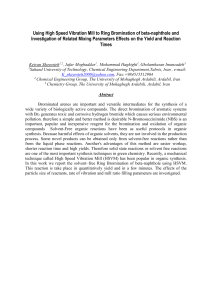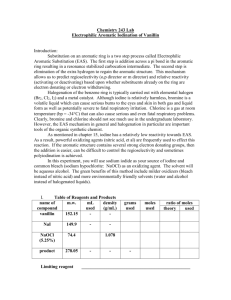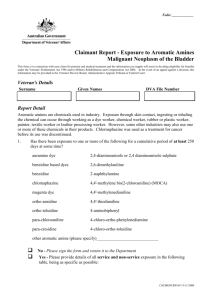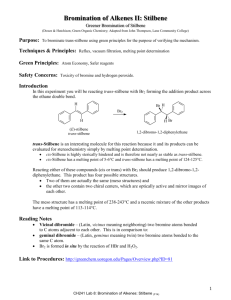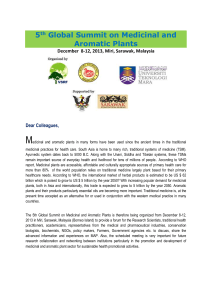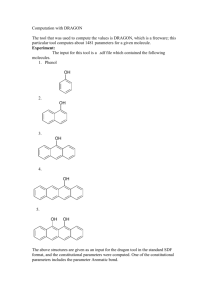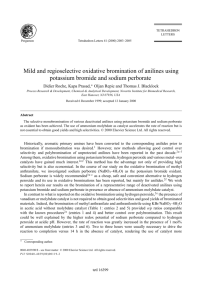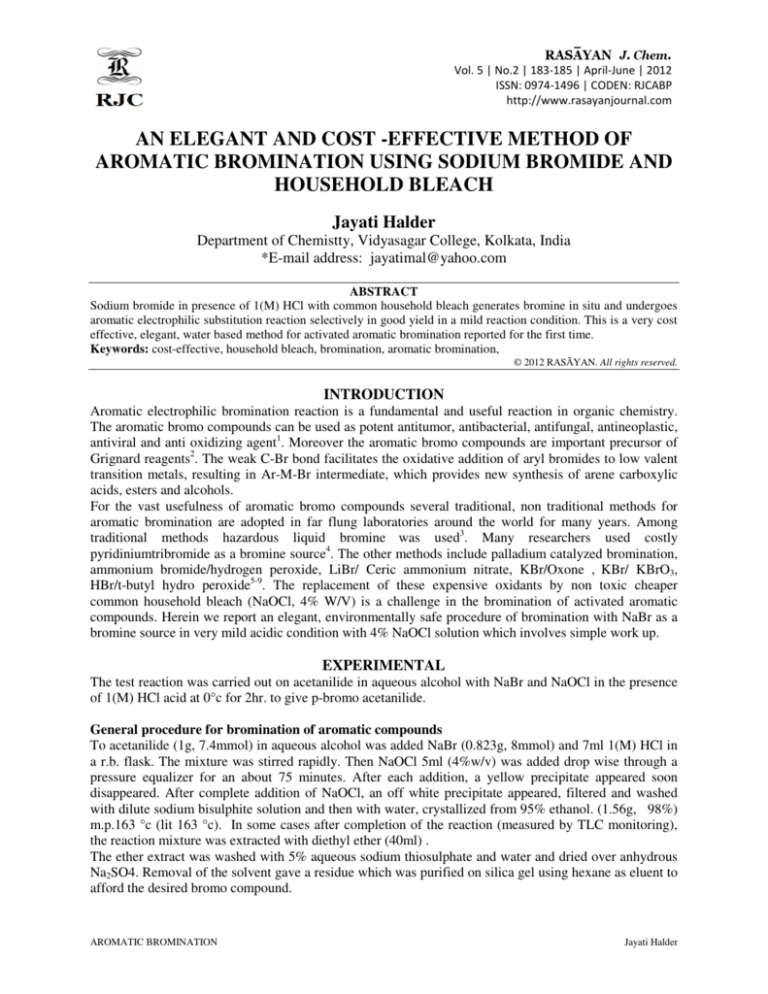
Vol. 5 | No.2 | 183-185 | April-June | 2012
ISSN: 0974-1496 | CODEN: RJCABP
http://www.rasayanjournal.com
AN ELEGANT AND COST -EFFECTIVE METHOD OF
AROMATIC BROMINATION USING SODIUM BROMIDE AND
HOUSEHOLD BLEACH
Jayati Halder
Department of Chemistty, Vidyasagar College, Kolkata, India
*E-mail address: jayatimal@yahoo.com
ABSTRACT
Sodium bromide in presence of 1(M) HCl with common household bleach generates bromine in situ and undergoes
aromatic electrophilic substitution reaction selectively in good yield in a mild reaction condition. This is a very cost
effective, elegant, water based method for activated aromatic bromination reported for the first time.
Keywords: cost-effective, household bleach, bromination, aromatic bromination,
© 2012 RASĀYAN. All rights reserved.
INTRODUCTION
Aromatic electrophilic bromination reaction is a fundamental and useful reaction in organic chemistry.
The aromatic bromo compounds can be used as potent antitumor, antibacterial, antifungal, antineoplastic,
antiviral and anti oxidizing agent1. Moreover the aromatic bromo compounds are important precursor of
Grignard reagents2. The weak C-Br bond facilitates the oxidative addition of aryl bromides to low valent
transition metals, resulting in Ar-M-Br intermediate, which provides new synthesis of arene carboxylic
acids, esters and alcohols.
For the vast usefulness of aromatic bromo compounds several traditional, non traditional methods for
aromatic bromination are adopted in far flung laboratories around the world for many years. Among
traditional methods hazardous liquid bromine was used3. Many researchers used costly
pyridiniumtribromide as a bromine source4. The other methods include palladium catalyzed bromination,
ammonium bromide/hydrogen peroxide, LiBr/ Ceric ammonium nitrate, KBr/Oxone , KBr/ KBrO3,
HBr/t-butyl hydro peroxide5-9. The replacement of these expensive oxidants by non toxic cheaper
common household bleach (NaOCl, 4% W/V) is a challenge in the bromination of activated aromatic
compounds. Herein we report an elegant, environmentally safe procedure of bromination with NaBr as a
bromine source in very mild acidic condition with 4% NaOCl solution which involves simple work up.
EXPERIMENTAL
The test reaction was carried out on acetanilide in aqueous alcohol with NaBr and NaOCl in the presence
of 1(M) HCl acid at 0°c for 2hr. to give p-bromo acetanilide.
General procedure for bromination of aromatic compounds
To acetanilide (1g, 7.4mmol) in aqueous alcohol was added NaBr (0.823g, 8mmol) and 7ml 1(M) HCl in
a r.b. flask. The mixture was stirred rapidly. Then NaOCl 5ml (4%w/v) was added drop wise through a
pressure equalizer for an about 75 minutes. After each addition, a yellow precipitate appeared soon
disappeared. After complete addition of NaOCl, an off white precipitate appeared, filtered and washed
with dilute sodium bisulphite solution and then with water, crystallized from 95% ethanol. (1.56g, 98%)
m.p.163 °c (lit 163 °c). In some cases after completion of the reaction (measured by TLC monitoring),
the reaction mixture was extracted with diethyl ether (40ml) .
The ether extract was washed with 5% aqueous sodium thiosulphate and water and dried over anhydrous
Na2SO4. Removal of the solvent gave a residue which was purified on silica gel using hexane as eluent to
afford the desired bromo compound.
AROMATIC BROMINATION
Jayati Halder
Vol. 5 | No.2 | 183-185 | April-June | 2012
1
HNMR spectral analysis and
spectrophotometer.
13
CNMR spectra were measured with a Varian Gemini 400-MHz
p-Bromo acetanilide
HNMR (d6 DMSO) δ2.04(s, 3 H,methyl), 7.45 (d,J= 8.34Hz,2H) 7.56(d,J= 8.52Hz,2H),10.06( broad
s,1H,NH) ppm.
13
C NMR (d6 DMSO) δ 24.4(CH3), 114.9(CH), 121.3(CH), 131.9(C-1), 139.1(C-4), 168.9 (carbonyl
carbon).
1
O
O
H
H
N
N
C
C
CH 3
CH 3
NaBr/household bleach (sodium hypochlorite solution)
room temperature/ 2 hoiurs
Br
Scheme-1
Table-1
Entry
Substrate
Temp.(°c)/
Time(h)
Product
M.P.(°c)
Yield%d
1
Acetanilide
rt/2
4--bromoacetanilide
169-170
98
2
vanillin
0-5 /2
5-bromo- vanillin
164-166
80
3
2-naphthol
5-10/ 2
1-bromo-2-naphthol
84-85
75
4
Salicylic acid
40-50/3
5-bromo-salicylic acid
203-205
85
5
p-hydroxy benzoicacid
0-5 /2
3-bromo-p-hydroxybenzoic
acid
176-178
90
6
p-methoxy benzoic acid
rt/overnight
3-bromo-p-methoxybenzoic
acid
7
8
9
10.
phenol
p-cresol
aniline
Cinnamic acid
bromo phenola
2,bromo-4-methyl phenol
bromo anilineb
Erythro-2,3-dibromo-3phenyl-propanoic acid
5-10/2
0-5/2
0/2
50/2
95
220-222
61-62
213-214 c
56-58
203-205
94
74
75
75
a
Para: ortho ratio 94:6 by GC analysis
Para: ortho ratio 80:20 by GC analysis
c
boiling point
d
All the compounds showed satisfactory spectroscopic data
b
RESULTS AND DISCUSSIUON
A number of different activated aromatic compounds with both electron withdrawing and electron
donating groups are subjected to the bromination reaction to prove the generality of this method and the
AROMATIC BROMINATION
184
Jayati Halder
Vol. 5 | No.2 | 183-185 | April-June | 2012
results are summarized in Table I. As expected all the substrates underwent bromination reaction in
excellent yield of mono brominated product.
The Table-1 summarizes the results on electrophilic aromatic bromination with household bleach and
sodium bromide.
CONCLUSION
In conclusion we can say that there are only a handful of methods for water based aromatic bromination.
The method described here develops a cost effective, elegant and safe procedure for bromination of
aromatic compounds. In future the direct handling of bromine should be avoided in chemical laboratories
to give a clean and safe environmemt
ACKNOWLEDGEMENTS
I am thankful to University Grants Commission, New Delhi for funding, UGC project No.F.PSW-036/0708.
REFERENCES
1.
2.
3.
4.
5.
6.
7.
8.
9.
G.W. Gribble, Chem.Soc. Rev., 28,335(1999)
K.C. Cannon, G.R. Krow, Handbook of Grignard Ragents; Dekker:New York,(1996)
M.Onaka, Y. Izumi, Chem. Lett., 2007(1984)
W.P. Reeves, R.M. King, A convenient method for bromination of aromatic amines, Synth.
Commun, 23,855 (1993)
Dipannita Kalyani, Allison R. Dick, Waseem Q. Anani and MelanieS. Sanford, Org. Lett., 8(12),
2523(2006)
K.V.V. Krishna Mohan, N. Narender, P. Srinivasu, S.J. Kulkarni, K.V. Raghavan,
SynthCommun.,34,2143(2004)
S.C. Roy,C. Guin, K.K. Rana, G.Maiti, Tetrahedron Lett. , 42,6941,(2001)
N. Narender, P. Srinivasu, M. Ramakrishna Prasad, S.J. Kulkarni and K. V. Raghavan, Syn.
Commun., 32,2313,(2002)
P.F. Schatz, J.Chem. Edu, 73,267,(1996)
[RJC-920/2012]
Water: Research & Development
[Water R&D]
www.waterrnd.com
ISSN: 2249-2003
[Abstracted in : Chemical Abstracts Service, USA and CAB(I) , UK]
________________________________________________________________________________________________________
WaterR&D is an international Research Journal, dedicated to ‘Water’. It is a truly interdisciplinary journal on water
science and technology. It’ll showcase the latest research related to Water in the field of chemistry, physics,
biology, agricultural, food, pharmaceutical science, and environmental, oceanographic, and atmospheric science.
It includes publication of reviews, regular research papers, case studies, communications and short notes.
Manuscript Categories: Full-length paper, Review Articles, Short/Rapid Communications.
Manuscripts should be addressed to:
E-mail: waterrd@gmail.com
AROMATIC BROMINATION
185
Jayati Halder

